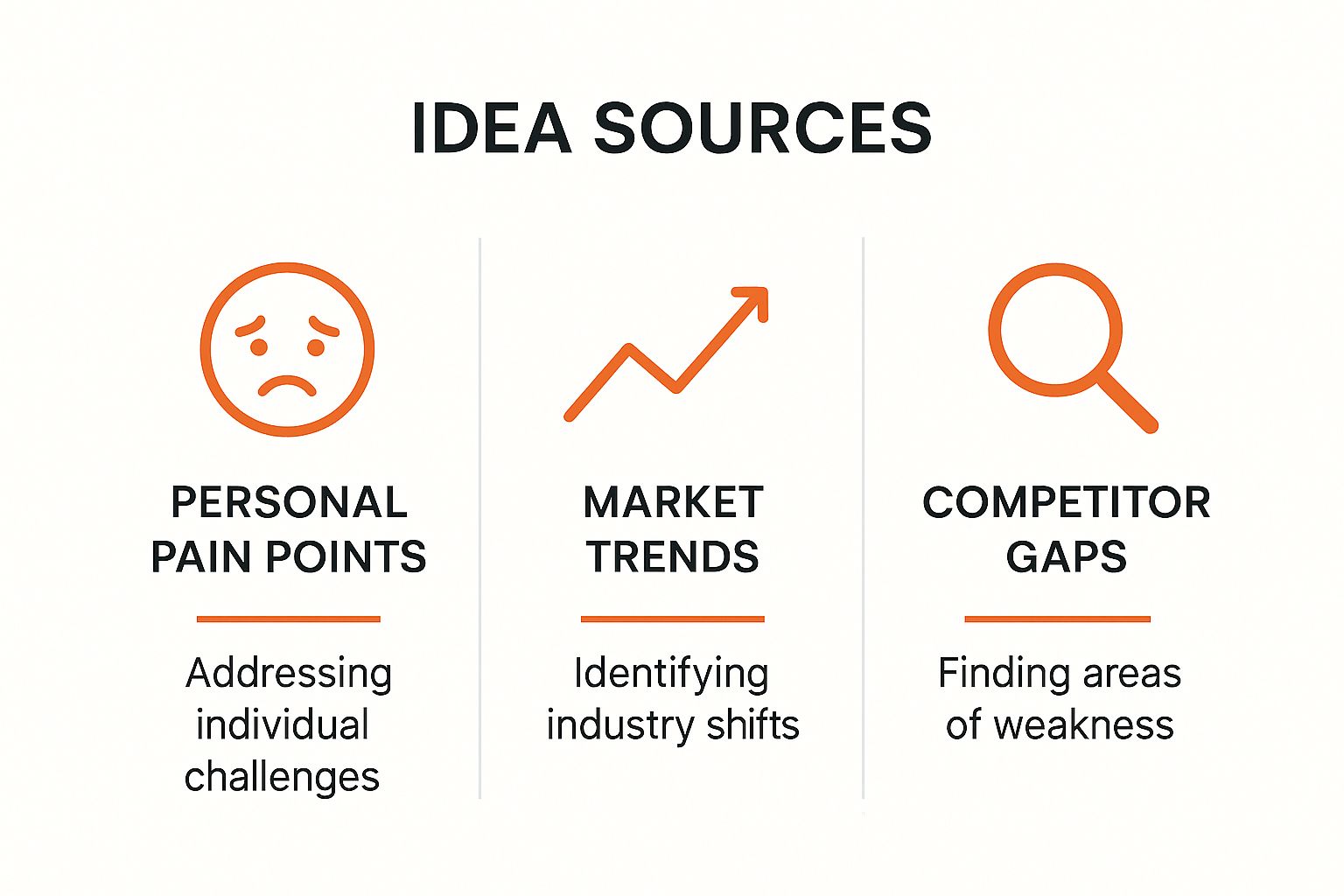Let’s be honest for a moment. The best way to find a great startup idea is to stop trying to invent one. Forget the whiteboard brainstorming sessions and the hunt for a "billion-dollar idea." The most successful founders I've known didn't pull a solution out of thin air. They found an existing, painful problem that people were already desperate to fix.
The secret is to find where your potential customers are complaining and use their frustrations as your direct roadmap.
Move Beyond Brainstorming to Find Real Startup Problems
That classic image of startup ideation—a team huddled around a whiteboard, dreaming up the next big thing—is, more often than not, a direct path to failure. Globally, about 21% of startups fail within their first year. That number balloons to a staggering 50% by the fifth year. One of the biggest culprits? Building something nobody actually needs. It's the inevitable outcome of solving imaginary problems.
Successful indie hackers and solopreneurs know this, and they flip the script. Instead of starting with a solution and then hunting for a problem to match, they begin by finding a painful, validated problem first. Only then do they build the solution. This "problem-first" approach dramatically stacks the odds in your favor because you're creating something with built-in demand from day one.
The Problem-First Mindset
Adopting a problem-first mindset is about shifting your focus from invention to observation. Your goal isn't to conjure a brilliant idea from nothing. It's to become a detective, an expert at identifying and validating the very real frustrations of a specific group of people.
The most profitable startup ideas are often sitting right there in plain sight, hidden within forum comments, social media rants, and subreddit discussions. Your future customers are literally telling you what to build; you just have to learn where to look.
You can often find these initial sparks in a few key places.

This visual shows that while ideas can spark from personal experience or market analysis, the strongest foundation is always a real, tangible problem someone is facing. To see just how different this is from the old way of doing things, let's compare the two approaches.
Comparing Ideation Methods
| Attribute | Traditional Brainstorming | Problem-First Approach |
|---|---|---|
| Starting Point | "What cool product can we build?" | "What painful problem can we solve?" |
| Focus | Solution-centric; technology and features | User-centric; pain points and needs |
| Validation | Happens after building (if at all) | Happens before writing a line of code |
| Risk | High risk of building something no one wants | Low risk; demand is pre-validated |
| Outcome | Often a "solution in search of a problem" | A product with a clear, defined market |
As you can see, the difference is stark. Grounding your idea in a genuine pain point moves you from the dangerous territory of guessing what people want to the much safer ground of knowing what they need.
If you're ready to dig deeper into this strategy, you can explore our guide on how to find the problem your startup should solve. It's all about making that critical mindset shift.
How to Mine Reddit for Actionable Pain Points
Let's be honest: Reddit isn't just a social media site. For anyone trying to build a business, it's one of the largest, most candid, and most searchable databases of human problems on the planet. I see it as an absolute goldmine, especially for indie hackers and solopreneurs looking for ideas that already have an audience.
Why? Because its communities, the subreddits, are hyper-focused. You have groups dedicated to specific industries, software, hobbies, and lifestyles, all filled with people openly discussing their frustrations.
You could, of course, do this the hard way. The manual approach means camping out in "problem-rich" communities like r/SaaS or r/smallbusiness. You'd spend your days searching for those magic phrases that signal a real need:
- "I wish there was a tool for..."
- "Does anyone else struggle with..."
- "How do you handle X? The current way is awful."
- "I would pay for a solution to this."
This works. I've done it. But it's a grind. You can easily sink hundreds of hours into sifting through thousands of posts just to unearth a few genuinely promising threads.
Automating Your Problem Discovery
This is where you can get a serious edge. While there's value in manual research, automating the discovery process gives you something much more valuable: speed and scale.
A tool like ProblemSifter was built specifically to solve this. It’s designed to scan targeted subreddits for the exact kind of problem-focused conversations we’re looking for. Instead of you spending weeks on manual searches, it hands you a curated list of validated pain points from real, unfiltered problems on Reddit.
Think about a typical Reddit feed. It’s a chaotic mix of memes, news, and discussions. Valuable insights are buried in there, but finding them is like panning for gold in a river of noise.

Trying to spot a single, actionable business idea in that sea of content demands immense patience and a fair bit of luck. A purpose-built tool cuts through all that, surfacing only the conversations that matter for building something new.
From Idea to First Contact
The real magic here isn't just about finding ideas—it's about the validation that comes with them. This is where the process becomes incredibly powerful. Unlike other tools that might spit out generic suggestions, this approach connects you directly to the source.
Unlike other tools, ProblemSifter doesn’t just suggest ideas—it connects you to the exact Reddit users asking for them. It gives you the original post and, crucially, the usernames of the people who actually have that problem.
This is a game-changer. You don't just have an abstract idea; you have a pre-vetted list of your first potential customers.
You can reach out immediately to ask clarifying questions. You can get their feedback on a quick mockup. You can even recruit them as your very first beta testers. This transforms Reddit from a passive listening post into an active laboratory for customer development. If you want to really master this, our guide on effective Reddit market research dives even deeper into the strategy.
Best of all, this isn't some expensive enterprise solution. For just $49, you can get lifetime access to a curated list of real startup problems people are discussing in one subreddit. For $99, you get three. It’s a simple, one-time payment—no subscriptions, no hidden fees—making it an incredibly affordable way to find and act on real-world opportunities.
Test Your Startup Idea Against Real-World Data
An idea, no matter how brilliant it sounds in your head, is really just a hypothesis. The most critical part of finding a startup idea that actually has legs is moving from assumption to evidence. This validation stage is where you confirm that real people not only have the problem you think they do but are also genuinely interested in how you plan to solve it.
The best part? You can do all of this before writing a single line of code, using the very same communities where you first spotted the problem. It’s all about de-risking your venture with real feedback, not just relying on your gut. In a world with over 150 million startups and about 50 million new ones launching every year, you need an idea grounded in proven demand to even have a chance.

Go From Observer to Participant
Once you've zeroed in on a recurring problem, your next move is to engage. But you have to be smart about it. The goal isn't a hard sell; it's intelligence gathering. You can pull this off with a few low-effort, high-impact moves:
- Launch Simple Polls: Put up a poll in the subreddit. Ask users to rank different frustrations related to the problem or choose between potential features. This gives you solid quantitative data on what truly matters to them.
- Run a "Smoke Test": Whip up a simple landing page that describes your solution and has an email signup for an "early access" or "beta" list. Pushing even a small amount of traffic to that page is the ultimate litmus test for genuine interest.
- Ask Smart Follow-up Questions: Jump into the original problem threads and ask clarifying questions. Try things like, "What have you already tried to fix this?" or "If you could wave a magic wand, what would the perfect solution do?"
This direct feedback is incredibly valuable. But it all hinges on one critical thing: you need direct access to the people who voiced the initial pain point.
This is exactly where most generic idea platforms completely miss the mark. They might hand you a vague problem, but then they leave you totally in the dark about who to actually talk to. The real magic happens when you can connect a specific problem directly to the people who are living it.
Having that direct line of communication is the fastest way to prove—or disprove—your assumptions. It stops you from wasting time building features nobody wants and keeps you aligned with real user needs from day one. For a more detailed look at this, check out our guide on how to conduct effective market research for startups.
Closing the Loop with Targeted Outreach
This is where a tool like ProblemSifter becomes so powerful. It doesn't just surface problems; it builds the bridge between your idea and the people who need it. It helps founders both ideate and promote their solution with targeted outreach.
It gives you the original post and, more importantly, the Reddit usernames of the people actively discussing the pain point. For indie hackers and solopreneurs, this is a total game-changer. It allows for hyper-targeted outreach to:
- Clarify the Problem: "Hey, I saw your post about struggling with X. Could you tell me a bit more about what makes it so frustrating?"
- Get Feedback on Mockups: "I'm working on a tool to solve this. Would you be open to giving me 5 minutes of feedback on a quick design?"
- Recruit Your First Beta Testers: "I've built an early version of a solution for the problem you mentioned. Would you be interested in being one of the first to try it out?"
This approach completely transforms the research process from a cold, anonymous task into a warm, conversational one. You're no longer just some random person building something in a vacuum; you're the person who actually listened and is now offering to help. That direct connection dramatically lowers the risk of your entire project and gives you the confidence to build something you know people are already waiting for.
Choosing the Right Tools for Startup Ideation
https://www.youtube.com/embed/mUlYuYooV5Y
Sure, you can spend weeks manually digging through forums and social media to find startup ideas. But as a builder, your time is your most precious resource. Using the right tool can cut that research time from weeks down to just a few days, letting you focus on what you do best: building.
The world of ideation tools is vast. Some platforms are great for spotting high-level trends, while others give you granular data on specific user problems. The key isn't just finding a tool with good data, but finding one with actionable data.
The Problem with Most "Idea" Tools
Many tools out there are focused on macro trends. They'll tell you what's hot or what's growing fast, which is great for understanding broad market shifts. But they often miss the specific, actionable details you need to build a real solution.
For instance, a trend tool might flag "AI tools for small business" as a booming market. That's true, but it doesn't tell you that a local bakery owner is manually rewriting product descriptions every week for her social media posts and desperately needs a way to automate it.
Other tools just aggregate generic startup prompts. This is a small step up, but it still leaves a huge gap. You get an "idea," but you have no connection to the real people who are actually experiencing the problem. That means you're starting your validation process from square one, hunting for an audience that might want what you've built.
The real goldmine for a founder isn't a tool that just gives you an idea—it's a tool that gives you an idea and an audience at the same time.
This is where a different kind of tool really makes a difference. Instead of just telling you what to build, it shows you exactly who to build it for.
From Unfiltered Problems to Your First Customers
This is precisely where ProblemSifter comes in, especially if you're a founder who believes in solving real problems first. The entire platform was built on a simple premise: the best startup ideas are buried in organic, unfiltered conversations. Its whole purpose is to connect you directly with user pain points discovered on Reddit.
ProblemSifter doesn't just hand you a generic idea; it links you directly to the Reddit users who are asking for a solution. This approach delivers a few major wins:
- Real Validation: You're tapping into genuine, unfiltered problems people are actively discussing, not just some theoretical market gap.
- A Built-in Audience: It doesn't just give you the idea. You get the original Reddit post and the usernames of the people who voiced the problem. This is your day-one list of potential customers.
- Effortless Outreach: This helps you find an idea and gives you a ready-made list for targeted outreach. You can get feedback, find beta testers, and even make your first sales.
This direct-to-user model is a genuine advantage for any solo founder or small team. The pricing is just as practical. Instead of another monthly subscription, it’s a one-time payment. For $49, you get lifetime access to a curated list of real startup problems from one subreddit. Or, you can get three subreddits for $99. It’s a straightforward, affordable way to find a validated idea and the very people who need it.
How Global and Industry Trends Shape Opportunity

A truly resilient startup idea rarely exists in a vacuum. It solves a specific problem, yes, but it also hooks into a much larger current—a powerful global or industry trend. When you learn to look beyond the immediate pain point and see these bigger shifts, you can transform a good idea into a great one. It's what gives a business staying power.
Think of it like sailing. Solving a customer's problem is like building a solid, seaworthy boat. But understanding market trends? That’s like knowing which way the tide is moving and the wind is blowing. You need both to build real momentum. For any founder, this means paying close attention to what's happening in the world to find the most fertile ground for a new venture.
Tapping Into Geographic and Ecosystem Growth
One of the most potent forces to align with is regional growth. From time to time, certain parts of the world erupt into hotspots for investment, talent, and innovation, creating a perfect storm for new companies. Keeping a pulse on these booming geographic and industry ecosystems can give you a serious edge.
For instance, data for 2025 shows the Asia-Pacific region is experiencing the most significant annual growth in its startup ecosystem. Countries like Singapore and China are posting staggering growth rates of over 44-45%. This surge is largely driven by huge investments in digital technologies, AI, fintech, and green tech. Diving into global startup ecosystem trends can give you a clearer picture of where this momentum is building.
A great idea often sits at the intersection of a specific, validated problem and a broader market trend. This foresight helps you solve today's problems while positioning your business for future growth.
This doesn't mean you have to pack your bags and move. It's about recognizing where capital and attention are flowing. A major trend towards green technology in Asia could be the validation you need for a carbon-tracking SaaS, even if you plan to launch with customers in your own city first.
Connecting Macro Trends to Micro Problems
The real magic happens when you connect these high-level trends to the tangible, everyday problems people are actually talking about. Trend reports are great for telling you what is growing, but tools like ProblemSifter help you uncover the why—the specific frustrations bubbling up inside those expanding markets.
Let's say you read about the explosion of the creator economy. That's the macro trend. Now, you can jump into ProblemSifter and analyze posts from subreddits like r/content_creation or r/youtube. This is where you find the micro-problems: creators complaining about tedious editing tasks, confusing analytics, or monetization struggles.
This two-pronged approach is incredibly powerful.
- Macro Trends (The "What"): Start by identifying a booming sector, like AI in marketing, remote work software, or sustainable e-commerce.
- Micro Problems (The "Who" and "Why"): Then, dig down to find the specific frustrations real people are facing within that sector.
When you marry these two perspectives, you uncover startup ideas that aren't just validated by a handful of user complaints. They’re also backed by a powerful, long-term market current. That dual validation is your ticket to finding opportunities with both immediate demand and lasting potential.
Answering the Tough Questions About Finding Your Startup Idea
Getting started is often the hardest part, and it's natural to have questions swirling around as you begin the hunt for a viable startup idea. Let's tackle some of the most common hurdles aspiring founders face and give you the practical perspective you need to push forward.
What if My Idea Already Exists?
First off, take a deep breath. This is almost always a good thing. The fact that someone else is already trying to solve the problem is one of the strongest forms of validation you can get. It proves a market exists.
Your job isn't to be the very first, but to be the best for a specific corner of that market. You can carve out your own space by being different, not just first.
- Go Niche: Focus on a specific user group the current players are overlooking or underserving.
- Create a Better Experience: Maybe their product is clunky or confusing. You can win with superior design and a smoother workflow.
- Rethink the Pricing: If they're locked into expensive monthly subscriptions, could you offer a more attractive one-time payment model?
Think about it—so many of the companies we use daily weren't pioneers. They simply saw what was working and executed it better for a particular audience.
How Can I Tell if a Problem Is Actually Worth Solving?
You're looking for two things: genuine pain and a willingness to pay to make it go away. It’s one thing for people to casually complain; it’s another for them to actively seek out solutions or hack together their own clumsy workarounds.
I’ve learned that comments like, "I would pay for this right now," or, "I've tried every tool and nothing works for this," are pure gold. That’s not just a complaint; it’s a buying signal.
This level of frustration is what turns a problem into a business opportunity. When you see a Reddit post describing a problem with hundreds of upvotes and dozens of comments all saying, "Me too!", you've found a strong indicator. It's far better to be an indispensable solution for a small, passionate group than an afterthought for a massive, indifferent one.
Should I Stick to an Industry I Already Know?
Having deep experience in a particular field gives you an incredible "unfair advantage." You instinctively get the nuances, the jargon, and the hidden frustrations that an outsider would spend months, or even years, trying to figure out. For a first-time founder, this is often the clearest path forward.
That said, it’s absolutely possible to break into a new market. The key is committing to deep, empathetic research. This is where a tool like ProblemSifter becomes so powerful. It lets you parachute into a new industry and analyze thousands of unfiltered conversations. You can quickly get up to speed on an audience's biggest pain points, almost as if you were an insider from day one.
Ready to stop guessing and start solving? With ProblemSifter, you can discover validated startup ideas directly from Reddit communities and connect with the very users who need your solution. Find your next big idea today.
